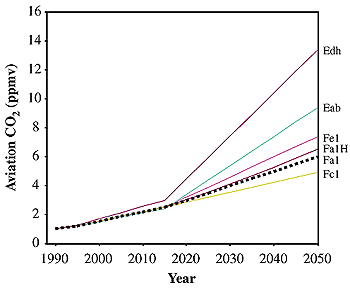|
6.1.4. Aviation's Contribution to the CO2 Budget
|

Figure 6-8: Atmospheric CO2 (ppmv) accumulated
from aviation's use of fossil fuel beginning in 1940.
|
Carbon dioxide released from fossil fuel combustion rapidly equilibrates among
atmosphere, surface ocean, and parts of the biosphere, leaving behind excess
atmospheric CO2 that decays slowly over the following
century (see carbon cycle discussion in IPCC, 1996). Thus, for CO2
radiative forcing, it makes no difference whether the fossil fuel is burned
in aircraft or other transportation/energy sectors, and the relative role of
aircraft can be found by comparing the history of fuel burned by aviation with
that of total anthropogenic carbon emissions.
Comparing projected IS92a carbon emissions from fossil fuels in Figure
6-6, CO2 emissions from aircraft in 1990 account
for about 2.4% of the total; they are projected to grow to about 3% (Fa1) or
more than 7% (Eab) of all fossil fuel carbon emissions by 2050. Sustained growth
in air traffic demand (5%/yr compounded) envisaged in Edh would lead to an aviation
fraction of more than 10% by 2050. By comparison, the entire transportation
sector is currently about 25% of the total (see discussion in Chapter
8). Clearly, different economic projections, as well as uncertainties in
predicting demand for air travel and aviation's ability to meet that demand,
can alter this aviation fraction by more than a factor of 2. Technology option
2 (low-NOx engines, Fa2) increases this fuel fraction
slightly to 3.2%, and the HSCT option increases this fraction from 3.1% (Fa1)
to 3.6% (scenario Fa1H, assuming no change in air traffic demand) by the year
2050.
The cumulative history of CO2 emissions allows us to
calculate the excess atmospheric CO2 concentration attributable
to aircraft, as shown in Figure 6-8. These calculations
are contributed by Jain, Wigley, and Schumann using carbon cycle models consistent
with IPCC (1996) and the IS92 scenarios therein. Aviation is estimated to be
responsible for about 1 ppmv of the 80 ppmv rise in CO2
from 1860 to 1990. Uncertainty in the prediction of atmospheric CO2
is estimated to be ±25%. Resulting CO2 radiative forcing
is only one part of aviation's climate impact. Other changes in greenhouse gases,
radiatively important aerosols, and clouds-as noted in Figure
6-1 and broken out in Table 6-1-must be included.
The remaining sections of this chapter examine aviation's total role in climate
change over the next 50 years for the example scenarios given in Table
6-3.
|